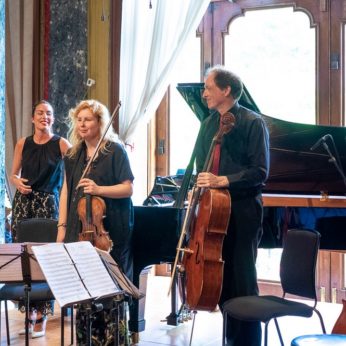Composer: Louise Farrenc (b. 1804 - d. 1875)
Performance date: 02/07/2019
Venue: Bantry Library
Composition Year: 1840
Duration: 00:33:59
Recording Engineer: Ciaran Cullen, RTÉ
Instrumentation: vn, va, vc, db, pf
Instrumentation Category:Piano Quartet/Piano Quintet
Artists:
Gloria Campaner -
[piano]
Malachy Robinson -
[double bass]
Christopher Marwood -
[cello]
Ellen Nisbeth -
[viola]
Mairead Hickey -
[violin]

Mairéad Hickey [violin] Ellen Nisbeth [viola] Christopher Marwood [cello]
Malachy Robinson [double bass] Gloria Campaner [piano]
Louise Farrenc [1804-1875]
Piano Quintet No.2 in E, Op.31 [1840]
1. Andante sostenuto – Allegro grazioso
2. Grave
3. Vivace
4. Finale – Allegro
Louise Dumont married Aristide Farrenc when she was only seventeen and he was 27. The Farrencs were an artistic dream team. He published her works, she proofread his publications, he researched early music, she annotated its performance practice, he spurred her to compose more, and, after he died in 1865, she saw through the publication of the final fifteen volumes of his 23-volume edition of 17th and 18th century keyboard music that was his life’s work.
With Aristide on flute and Louise on the piano, they toured together after their marriage but soon swapped the itinerant life of chamber musicians for a base in Paris. Éditions Farrenc – an imprint which came to be known Europe-wide – launched with a French edition of Beethoven’s Fidelio. The House moved swiftly to buy rights to Chopin’s compositions but Aristide found him too eccentric and lazy to be a serious collaborator.
Six years Louise Farrenc’s junior, Chopin’s virtuosity and improvisational brilliance gave him currency in Paris salons – the only rival to the hegemony of opera in the city. Farrenc was a well-respected concert pianist with a mastery evident in the piano parts of all her works, but audiences didn’t swoon for her. She wrote musique sérieuse – lacking the technical flourishes and programmatic elements needed to capture a Parisian audience. Farrenc’s mature oeuvre – non-programmatic chamber music and orchestral works – would have been better received by a German audience but France was more receptive than Germany to the compositions of a woman.
The concert hall adjacent to the offices of Éditions Farrenc was one of the few chamber music venues in the city and there, during the concert season, the Farrencs held a series of Monday Matinées. Both of Farrenc’s Quintets were premiered at these concerts, the First with the couple’s daughter, Victorine, at the piano. It was impossible for almost any chamber work to be a popular success in Paris, but the First Quintet impressed critics and Aristide encouraged Louise to write a second, this time in a major key. The instrumentation with double bass instead of second violin was more likely due to the availability of Achille Gouffé, the famous bass player in the Paris Opera than to Schubert’s example.
Where Farrenc’s First Quintet begins in media res, the Second announces itself. Declamatory chords are played by the full ensemble with a rumbling piano beneath. The texture then lightens, builds, and waits for the cello melody of the Allegro Grazioso. Upholding the classical forms that her contemporaries abandoned, short block chords on the piano mark the passage to the repeated section and to the development.
The second movement opens with a simple and sincere violin melody followed by a more romantic theme from the cello. The music moves from a gentle simplicity to increasing emotional depth and complexity. The brief Scherzo, with accents on the last note of every three, has a nervy energy. The more regular second subject is accompanied by the piano sweeping to vertiginous heights and whizzing back down like a slow-motion siren. Intensity builds to unexpected pauses and the melody makes diversions. The melodic trio section soon returns to the syncopated opening and the movement races to a finish.
The Finale releases all the composer’s pent-up energy with her instrument leading the way. The violin breaks through with a soaring melody. The violin and viola are rhetorical opponents in development passages. After the mellowest passage of the movement, the ensemble launches into the Più Allegro with the pianist climbing to the instrument’s highest reaches before the drop into the final chords.
Mary-Ellen Nagle
Copyright © 2024 West Cork Music. All rights reserved.
Designed and developed by Matrix Internet